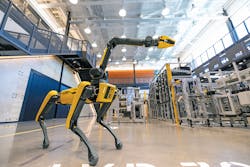The term ‘Fourth Industrial Revolution’ — or Industry 4.0 — was introduced as a German government initiative in 2011, but soon found its way into public discourse. The concept gained widespread recognition in 2016 when the World Economic Forum’s annual meeting debuted ‘Mastering the Fourth Industrial Revolution’ as its theme.
“Since the 2016 Davos forum, when Industry 4.0 was essentially published in the social psyche, pretty much everybody has been trying to figure out how to make their buildings and manufacturing facilities more modern,” says Laks Pernenkil.
Pernenkil, who now serves as principal and practice leader for Deloitte Consulting’s Life Sciences Product, Supply and Manufacturing practice, has witnessed this manufacturing evolution firsthand.
“In the last half-decade, the focus of manufacturing organizations has been to shift from a legacy lean and Six Sigma operations efficiency paradigm to a digitally accelerated, next-gen technology-enabled smart manufacturing model,” says Pernenkil.
But it hasn’t been an easy victory for companies on the plant floor, and for pharma, it’s been especially daunting.
“The curse of the manufacturing environment in general is that these are long range depreciated assets. So, you can’t just flip a switch — it takes a lot of planning, even in a simple manufacturing environment,” says Pernenkil. “When you add on the regulated manufacturing environment, the transformation is extremely difficult.”
Yet with the pharma industry facing mounting pressure to bring high quality, cost-effective drugs to market faster, smart factory deployments are proving worth the effort, as companies are now realizing tangible improvements in manufacturing performance.
Pharma complexities
The pharma industry often faces a strange juxtaposition — it is tasked with making novel cutting-edge medications, using legacy equipment in aging facilities. This puts pharma in a position that is familiar to much of the broader manufacturing industry when it comes to digitalization: Companies have to decide between retrofitting existing facilities or building entirely new plants.
“The biggest challenge in front of the pharma industry is that they are almost always trying to balance the ROI of ‘should I retrofit my existing site and increase the efficiencies?’ or ‘should I just go ahead and build a new site that is completely automated?’” says Pernenkil.
So which is the better option for pharma? According to Pernenkil, it depends. While companies will likely save on costs in a retrofitting project, the complexity can be significantly higher.
“And only 30% of that complexity is technology,” says Pernenkil. “Most of it is humans, because you have to change the way that people work within that existing site.”
Technology’s role, per Deloitte, is to enable smart factory capabilities in a compliant way. But the smart factory itself requires business functions to operate in a connected way — and this can’t happen without employees embracing the evolution of the future of work.
The alternative to retrofitting, of course, is to start from scratch. According to Pernenkil, while new builds tend to be less complex, they are not without constraints. During the thick of the pandemic, for example, companies ran into issues with contractor capacity — and projects were sitting on the market for months with no bids.
The other big consideration for the pharma industry is time — often site success hinges on the efficient launch of a specific product looking to gain market share. Which means, even if a company has the best intentions — to build a brand new ‘facility of the future’ — tight timelines often ruin those plans.
“Because each new facility under construction is being built for some set of new products on the market, the timelines of product launches force pharma companies to commission and start the site, and not spend a lot of time and investment to ‘future proof’ effectively,” says Pernenkil. “So all your beautiful visionary ideas of how it’s going to be a no-touch, facility of the future go out the window pretty quickly because you have a certain timeline to maintain.”
In Pernenkil’s experience, most companies usually settle on middle ground — a combination of retrofitting some sites and then creating new builds featuring next-gen technology.
Smart factory ROIs
Regardless of how companies get there, the question on everyone’s mind is what are the tangible benefits of going ‘smart’?Last year, Deloitte, in collaboration with Wichita State, opened the doors to a hands-on, experimental smart manufacturing environment known as The Smart Factory @ Wichita. In addition to helping leaders build a vision for smart manufacturing success, the program collects data that helps back the business case for the smart factory, demonstrating measurable improvements to asset efficiency, quality, safety and sustainability.
On the plant floor, smart factory technologies such as IoT, augmented reality and sensor-enabled monitoring can predict equipment problems before they happen and calculate available capacity based on demand, reducing downtime and increasing overall equipment effectiveness.
On the sustainability side, tools such as motion sensors, microclimate controllers and AI pattern detection optimize energy levels in real time, reducing costs. In the quality department, vision systems, smart sensors and real-time analytics can be used to accelerate quality inspections.
Pernenkil estimates that a smart factory can yield operating expenditures that are five to seven times lower than what might be typically seen in a traditional plant.
Because having pharma production lines go down is extremely costly, traditionally, much of the labor force expense on the production floor comes in the form of people who are supporting operators — maintenance technicians, quality technicians, sampling technicians, etc.
But a smart factory offers relief from those costs.
“The operating expense of a typical plant has a lot more overheads, whereas the smart factory will give you more leverage because you are proactively solving for issues,” says Pernenkil. “Therefore, you are able to have a smaller pool of specialized technicians that can solve a wider array of problems because you have the plant telling you with data where to focus and what is happening on the production floor.”
Where pharma stands
While the pharma industry has developed a reputation for being slow adopters of technology, over the past five years, Pernenkil has seen a commitment to foundational digital infrastructure across the industry.
“Almost every client that I know has made the commitment to invest in core systems and core capabilities,” says Pernenkil. “There are very few companies, if any, that have not taken the leap into digitizing infrastructure.”
A persistent obstacle for the pharma industry has been making sense of the tremendous amount of data it generates. Recently, Pernenkil has noted an increased emphasis on gathering data from the production floor — process data, quality data, equipment data, environmental data — and using it in ways that bring real value. Some Deloitte clients have built data fabrics that collect and contextualize data, and then generate insights using AI. These insights can then be used by operators to take the best action on the production floor.
“A manufacturing floor typically creates a terabyte of data per day, and barely 5% of that gets used at all in any form of decision-making. We are out to help our clients change that,” says Pernenkil.
About the Author
Karen P. Langhauser
Chief Content Director, Pharma Manufacturing
Karen currently serves as Pharma Manufacturing's chief content director.
Now having dedicated her entire career to b2b journalism, Karen got her start writing for Food Manufacturing magazine. She made the decision to trade food for drugs in 2013, when she joined Putman Media as the digital content manager for Pharma Manufacturing, later taking the helm on the brand in 2016.
As an award-winning journalist with 20+ years experience writing in the manufacturing space, Karen passionately believes that b2b content does not have to suck. As the content director, her ongoing mission has been to keep Pharma Manufacturing's editorial look, tone and content fresh and accessible.
Karen graduated with honors from Bucknell University, where she majored in English and played Division 1 softball for the Bison. Happily living in NJ's famed Asbury Park, Karen is a retired Garden State Rollergirl, known to the roller derby community as the 'Predator-in-Chief.'

